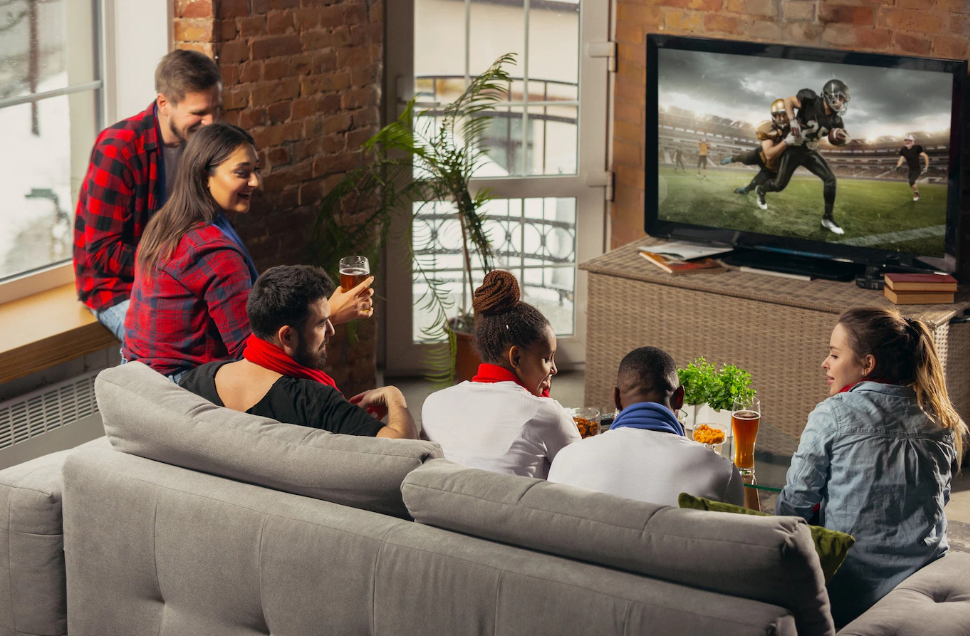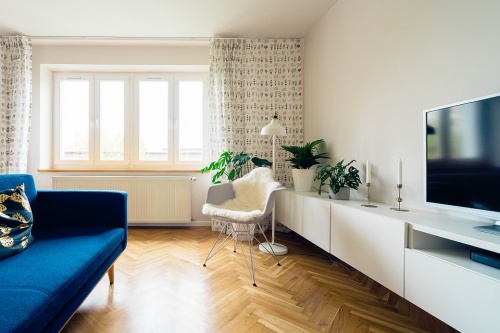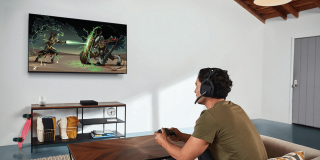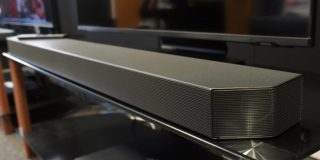What Size TV Do You Need for the Best Movie Viewing Experience?

When buying a new TV, one of the first questions you need to ask yourself is what TV size you should get. Modern TVs are available in different sizes, from 32 to 85 inches (always diagonally). For the best movie-watching experience, you need a bigger TV, usually somewhere between 55 and 75 inches. The size of your TV should mainly depend on the distance between the TV and the seating area and how much money you’re prepared to spend on it.
This article will discuss what size TV you need to turn your living room into a home theater. Additionally, we’ll show you how to calculate the optimal TV size based on the viewing distance and other factors.
How to Decide What Size TV You Need for the Best Movie Viewing Experience
For the perfect movie-watching experience, the size of your TV screen plays an important role. When it comes to TV sizes, the expression “the bigger, the better” definitely applies. However, there are many other factors you need to consider before picking a TV on size alone.

Modern TVs come in a wide variety of sizes, including 32, 40, 43, 50, 55, 60, 65, 75, 80, and 85 inches. The most commonly sold household TVs are 50, 55, and 65-inch models.
Keep in mind that TVs aren’t measured horizontally. Their length is estimated diagonally, from one corner to the other. So, for example, a 40-inch TV is actually 35 inches long and 20 inches tall. It’s important to know this before you start measuring the space where you plan to put the TV. Many people who aren’t aware of this fact realize the TV they wanted is much smaller than they thought.
Here are some factors you need to consider when choosing a TV size.
The Size of Your Room
One of the first factors you need to look at is the size of the room. If you’re planning to put a TV in a small room, an oversized screen will only make the room look and feel smaller. A large TV will also take up valuable space and might not fit on a cabinet. However, if the room in question is vast with plenty of empty wall space, it’s safe to put a huge TV in there.

Smaller, 32-inch TVs are a better solution for one-person bedrooms and small apartments, and they’re suitable for individuals. A living room or a larger space would look better with a bigger TV. To make the best home theater where all your friends can watch movies, a 55-inch or a 65-inch TV would be perfect.
The Viewing Distance
The viewing distance refers to the space between the TV and the seating area, and it’s another important factor you need to think about. If the seating area is too close to the TV, it will be bad for your eyes. What’s more, you won’t be able to see the whole screen, and you will constantly have to turn your head to avoid missing significant details.

However, for the best movie-watching experience, you don’t want the TV to be too far away either. You’ll be forced to squint the whole time, trying to read captions or spot smaller details on the screen.
If you want a bigger TV, you need to leave enough space between the TV and the seating area to see the entire screen. It’s generally advised to leave at least 9 feet (2.7 meters) between your TV and the seating area. This rule applies to larger models.
For a 32-inch TV, there should be at least three to four feet between you and the screen, which is approximately 32 to 48 inches. When it comes to slightly larger 40-inch TVs, you should be seated 4 to 5 feet away from the screen.
The Placement
The placement of the TV also matters. Be careful not to put the TV too high on the wall. Your neck will become stiff after just 10 minutes, and you will have to sit in an uncomfortable position to watch anything. You should also consider the angle of the TV. For an optimal viewing experience, you’ll want your TV to be placed at a 30 to 40-degree angle. Remember, the larger the TV, the wider the viewing angle.

If you want to place the TV on a wall, make sure it’s mount-friendly. Whether or not a TV can be mounted on the wall doesn’t depend on its size. Generally, smaller TVs are much easier to mount since they weigh less. Mounting the TV to the wall can save you a lot of space.
TVs with stands should be placed on a solid, sturdy surface big enough for the whole device to fit. Larger rooms and lots of space can look better and appear full with an entertainment stand.
The Resolution
The viewing distance should also help determine the display’s resolution. If you’re planning to sit closer to the TV, make sure to choose a TV with a higher resolution. The better the resolution, the harder it is to detect the pixels on the screen.

You can choose between HD (1280 x 720), Full HD (1920 x 1080), and ultra-HD or 4K (3840 x 2160) resolution. Standard TVs offer a Full HD resolution, which is sufficient for a regular viewing experience. However, for the best movie-watching experience, you can’t go wrong with a 4K TV.
Ultra-HD, or 4K TVs, take your movies and shows to a whole other level. One downside to 4K TVs (except for their price) is that not all content is made for 4K resolution. In other words, you won’t be able to take advantage of the UHD resolution unless you find 4K content. Although, various streaming services available on smart TVs offer 4K content, including Netflix, HBO Max, Hulu, Disney+, Amazon Prime Video, and more.
If you’re planning to get a smaller TV, like a 32-inch model, note that they aren’t available in 4K. Samsung TVs are an exception to this rule, as the company currently has the only 32-inch 4K TVs available on the market. Apart from Samsung models, TVs need to have at least 40 inches for 4K resolution.

The Budget
The price of the TV is mainly determined by its size, with other features, like resolution, lighting, and HDR support adding to the cost afterward. The good news is that even larger TVs are becoming increasingly affordable. However, a large 4K HDR smart TV will still cost a lot more than a smaller Full HD TV. Some TVs can even have the exact same size but still be placed at opposite points of a price range.
High-end, large TVs are more likely to come at a higher price, especially if they have 65, 75, or 85 inches.
Household Members
The number of family members or people who share the same space should also be considered when choosing a TV size. A bigger TV would be required for a large family or a household with lots of people. If you want to get a TV to organize movie nights or create the perfect home theatre, bigger is better. Jumbo-sized TVs that have 75 inches and more are optimal for movie-watching. But you need to be prepared to pay a higher price if you want to go all-out on size.
Personal Preference
Your decision should ultimately depend on your personal preference. You might be more comfortable with a smaller or larger TV. The TV you want to buy may not even be available in many sizes, so just choose a TV that fits your living room best.
How to Calculate the Optimal TV Size

If you’re still not sure what size TV you need for the best movie viewing experience, there is a way to calculate the optimal TV size based on the viewing distance.
First, decide exactly where the TV will be placed. The next step is to measure the distance between the TV and the seating area with a tape measure. Write down the viewing distance in inches. For example, if the viewing distance is 9 feet, write down 108 inches on a piece of paper.
Next, multiply that number by 0.667 (or 2/3). The result will reveal the maximum TV size for that viewing distance. In this case, we multiplied 108 by 0.667, which equals 72. This means that you shouldn’t buy a TV with more than a 72-inch diagonal.
You can also use another simple equation to determine whether the TV is in your viewing range. This is done by multiplying the size of the TV by 2. For instance, if you choose a TV that’s 54 inches, multiply it by 2, and you’ll get 108. In other words, if the viewing distance is 108 inches, the optimal TV size is 54 or 55 inches. If you’re planning to buy a 4K TV, you can multiply the TV size by 1.5 since 4K resolution allows you to sit closer to the screen.
The best thing you can do is just make a cardboard cutout of the TV size you’re planning to get and place it on the wall or stand. Make sure to walk around the room and sit in different places to view it from all angles. This way, you’ll be certain you’re getting the right size.
Choose the Best TV Sizes for Your Home Theatre
Picking a TV size is no easy decision. There are various factors you need to think about, like the viewing distance, the size of the room, the resolution, where you’ll put the TV, and much more. If you’re worried you might get the wrong size, just remember, hardly anyone has ever complained about getting a TV that’s too big. That being said, you can always use the simple equations provided above to estimate the optimal TV size for the best movie viewing experience.
















